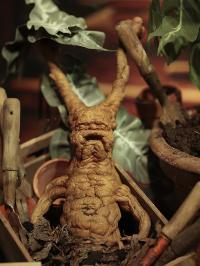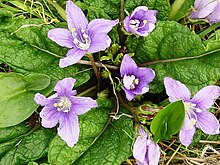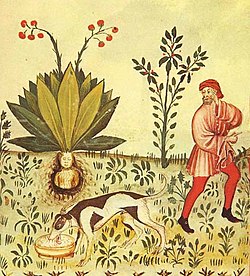Mandrake (mandragora officinarum) is a real thing. Not just the product of J.K. Rowling's rich
But there is an ancient myth that says mandrake roots scream when pulled from the earth—and that anybody who hears the scream will die.
The historian Josephus of Jerusalem (circa 37–100 AD) wrote the following instructions for digging up the mandrake root to avoid the scream-dying-thing curse.
"A furrow must be dug around the root until its lower part is
 |
| A Harry Potter Mandrake |
Not a great time to be a dog.
The reason the irresponsible pet owners wanted to pull up the plants was probably the purported medicinal properties of the mandrake root, which were considerable. It was used as a sedative, laxative, painkiller, aphrodisiac, fertility aid, and a cure for erectile dysfunction.
 |
| Mandrake flowers |
Like foxglove and Jimson weed, Mediterranean Mandrake, mandragora officianrium, is a member of the nightshade family. Like them, it affects brain chemistry and produces frightening hallucinations. English Mandrake, Bryonia alba, is a member of the cucumber family, and all its parts are extremely poisonous. It produces a bluish berry, forty of which can kill.
The myths surrounding mandrake are as varied as they are bizarre.
- Ancient Anglo-Saxons carried the root as a talisman to repel evil
- In the Bible, it is mentioned as a coveted fertility aid. (Genesis 30: 14-16)
- In ancient Persia, couples put the roots under their beds in order to conceive.
- Medieval witches smeared an ointment containing a tincture of the root in order to fly.
- Joan of Arc was accused of carrying an amulet made of the dried root in order to communicate with Satan.
- In medieval Europe it was said that the plants originated near gallows, where they sprang from the semen of hanged men.
 |
| English Mandrake aka bryonia alba |
Mandrake's rich mythology appears quite often in literature. I remember being puzzled as a young teen by John Donne's poem of impossible goals:
"Go and catch a falling star
Get with child a mandrake root"
And Shakespeare loved the stuff:
"Shrieks like mandrakes' torn out of the earth."...Romeo and Juliet IV.iii
"Would curses kill, as doth the mandrake's groan"...King Henry VI part II III.ii
"Give me to drink mandragora ...That I might sleep out this great gap of time my Antony is away." ...Antony and Cleopatra I.v
Do you have some Mandrake stories to add? There's so much folklore attached to this strange looking plant!
Here's a list of all the posts in the poison series
Part 13: Datura
THE LADY OF THE LAKEWOOD DINER
99c at Amazon for a limited time!
A comedy that pokes fun at the myth of a Golden Age, making parallels between the Grail legend and the self-mythologizing of the Baby Boomer Generation.
Someone has shot aging bad-girl rocker Morgan Le Fay and threatens to finish the job. Is it fans of her legendary dead rock-god husband, Merlin? Or is the secret buried in her childhood hometown of Avalon, Maine?
Morgan's childhood best friend Dodie, the no-nonsense owner of a dilapidated diner, may be the only one who knows the dark secret that can save Morgan's life. And both women may find that love really is better the second time around.
"A page turning, easily readable, arrestingly honest novel which will keep you laughing at yourself. Who doesn't remember crashing on a mattress at a friend's apartment with the stereo blasting Iron Butterfly and no idea where you'll stay the next night? A cultural masterpiece for the discerning reader."...Kathleen Keena, author of Adolescent Depression, Outside/In



This has got to be one of my favorite posts about poisons. This root intrigues me. I loved it in the Harry Potter series. Who didn't, right? I wonder, though, about the screaming myth. Hmmmmmm
ReplyDeletePatricia--Isn't that a wild story? And it's ancient--even pre-Biblical--and appears in many cultures, from India and the Middle East to the British Isles.
DeleteThat's one nasty root. It gave me the shivers just looking at it. Loved reading the post though. Stopping in after exchanging thoughts on IWSG.
ReplyDeleteClee--It's obviously scared people for millennia, which must be what sparked all the bizarre stories. Thanks so much for coming over from the IWSG. It all goes to prove the power of blogging doesn't it?
Delete